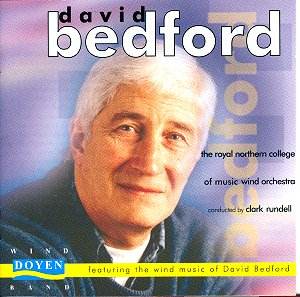Anyone who is familiar with David Bedford only through
his early work (I’m thinking of such pieces as Star Clusters, Nebulae
and Places in Devon and several of the other celestial inspired
works of the sixties and seventies) would, I suspect, be hard pressed
to recognise the music on this disc as being by the same composer. In
reality however, it is no great surprise that Bedford’s music underwent
a gradual change during the late seventies and early eighties. After
early studies with Lennox Berkeley and Luigi Nono his initial immersion
in the world of the avant-garde always ran parallel with his involvement
in popular music, working regularly with such figures as Mike Oldfield
and also undertaking arrangements for a wide range of mass market artists.
The compositional style that was to emerge from this
post avant-garde world was strongly melodic, unashamedly tonal and not
uninfluenced by the popular music that had always been part of his musical
persona. A good example can be found in the Symphony No. 1 of
1985 (NMC D049). The Symphony is contemporaneous with several of the
wind band pieces on this disc and is not too distant from them, both
melodically and in the use of certain rhythmic devices that crop up
regularly in his work.
Sun Paints Rainbows on the Vast Waves was the
first of a number of wind band pieces that was to create something of
a reputation for Bedford as fresh interest began to grow in symphonic
wind bands. This was largely as a result of the work of Timothy Reynish
and Clark Rundell at the Royal Northern College of Music in Manchester.
The work takes its title from the notebook of Coleridge when he was
writing The Rime of the Ancient Mariner, "the Sea was then very
much tossed, and the Wind carrying off the Tops of the Waves made a
kind of Rain, in which the rays of the Sun, painted the Colours of the
Rainbows". Bedford creates what amounts to a tone poem, based largely
on the eight chords heard at the outset. As in much of Bedford’s music
considerable use is made of repeated ostinato-like rhythmic figurations
that occur regularly and are a stylistic remnant of his avant-garde
days. The initial eight chords are subjected to a range of transformations
and metamorphoses, heard most obviously in the middle section where
they are presented in a series of static blocks set against percussion.
The work still remains the freshest of the five pieces
heard here, being melodically appealing, skilfully and imaginatively
scored and challenging yet rewarding for the players, a fact that is
clearly communicated by The Royal Northern students. The disappointment
is that what follows is much of the same. The remaining works sharing
closely related melodic material and often predictably familiar rhythmic
devices. Praeludium is a brief celebratory concert opener, originally
written in the run up to the unsuccessful Manchester bid for the 1996
Olympics. Canons and Cadenzas features some clever rhythmic interplay
and is once again attractively scored with opportunities for individual
players to shine before its unexpectedly understated ending. Sea
and Sky and Golden Hill is perhaps the closest work to Sun Paints
Rainbows in its visual associations. The John Adams-like rhythmic
patterns of the opening eventually build to a final climax noticeably
similar to that of the third movement of the Symphony No. 1 written
in the same year, only to subside to a gently oscillating conclusion.
The exception amongst these pieces is Ronde for Isolde, the only
work written for junior or amateur forces. It comprises a set of variations
on the well known "Ronde" by Tielman Susato, superimposed
in the slow central section with a series of chords heard during the
second act of Wagner’s Tristan and Isolde.
Taken in isolation, each of these pieces has its appeal
yet there is a feeling that Bedford is rather over working the same
basic material. The result is a disc to dip into rather than to take
on board in one dose. The performances by The Royal Northern College
of Music Wind Orchestra are both vivid and strongly committed.
Christopher Thomas

![]() Royal Northern College
of Music Wind Orchestra/Clark Rundell
Royal Northern College
of Music Wind Orchestra/Clark Rundell ![]() DOYEN DOY CD 082 [58:40]
DOYEN DOY CD 082 [58:40]